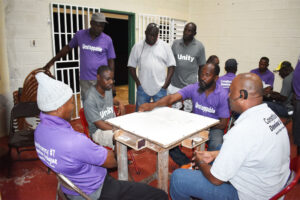Published 30 July 2020
Buckie Got It, St. Kitts and Nevis News Source

Don’t drive in flooded areas — turn around, don’t drown!
National Weather Service: Turn Around Don’t Drown®external icon
Floodwater can pose a drowning risk for everyone— regardless of their ability to swim. Swiftly moving shallow water can be deadly, and even shallow standing water can be dangerous for small children.
- Always follow warnings about flooded roads.
- Don’t drive in flooded areas—cars or other vehicles won’t protect you from floodwaters. They can be swept away or may stall in moving water.
Stay out of floodwater.
Floodwaters contain many things that may harm health. We don’t know exactly what is in floodwater at any given point in time. Floodwater can contain:
- Downed power lines
- Human and livestock waste
- Household, medical, and industrial hazardous waste (chemical, biological, and radiological)
- Coal ash waste that can contain carcinogenic compounds such as arsenic, chromium, and mercury
- Other contaminants that can lead to illness
- Physical objects such as lumber, vehicles, and debris
- Wild or stray animals such as rodents and snakes
Exposure to contaminated floodwater can cause:
- Wound infections
- Skin rash
- Gastrointestinal illness
- Tetanus
- Leptospirosis (not common)
It is important to protect yourself from exposure to floodwater regardless of the source of contamination. The best way to protect yourself is to stay out of the water.
If you come in contact with floodwater:
- Wash the area with soap and clean water as soon as possible. If you don’t have soap or water, use alcohol-based wipes or sanitizer.
- Take care of wounds and seek medical attention if necessary.
- Wash clothes contaminated with flood or sewage water in hot water and detergent before reusing them.
If you must enter floodwater, wear rubber boots, rubber gloves, and goggles.
Prevent injuries.
Floodwater may contain sharp objects, such as glass or metal fragments, that can cause injury and lead to infection. Prompt first aid can help heal small wounds and prevent infection.
If you receive a puncture wound or a wound contaminated with feces, soil, or saliva, have a health care professional determine whether a tetanus booster is necessary based on individual records.
For more information, visit: Emergency Wound Care After a Natural Disaster
Prevent infection of open wounds and rashes.
Open wounds and rashes exposed to floodwater can become infected. Vibrios, for example, are naturally occurring bacteria that live in certain coastal waters and can cause skin infections when an open wound is exposed to them. This can happen during floods. To protect yourself and your family:
- Avoid exposure to floodwater if you have an open wound.
- Cover clean, open wounds with a waterproof bandage to reduce chance of infection.
- Keep open wounds as clean as possible by washing well with soap and clean water.
- If a wound develops redness, swelling, or oozing, seek immediate medical attention.
Seek medical attention as soon as possible if:
- There is a foreign object (soil, wood, metal, or other objects) embedded in the wound;
- The wound is at special risk of infection (such as a dog bite or a puncture by a dirty object);
- An old wound shows signs of becoming infected (increased pain and soreness, swelling, redness, draining, or you develop a fever).
For more information, visit: Emergency Wound Care After a Natural Disaster
Protect yourself and your loved ones from diarrheal diseases.
Be aware that floodwater may contain sewage, and eating or drinking anything contaminated by floodwater can cause diarrheal disease (such as E. coli or Salmonella infection). To protect yourself and your family:
- Wash your hands after contact with floodwater. Also be sure to wash children’s hands with soap and water often and always before meals.
- Do not allow children to play in floodwater areas.
- Do not allow children to play with toys that have been contaminated by floodwater and have not been disinfected.
- Do not bathe in water that may be contaminated with sewage or toxic chemicals. This includes rivers, streams, or lakes that are contaminated by floodwater.
For more information, visit:
- Personal Hygiene and Handwashing After a Disaster or Emergency
- Handwashing, Hygiene, and Diapering
- Cleaning and Sanitizing with Bleach
- CDC Floodwaters or Standing Waters
Protect yourself from animal and insect bites.
Floodwater can displace animals, insects, and reptiles. To protect yourself and your family, be alert and avoid contact.
For more information, visit: Protect Yourself from Animal- and Insect-Related Hazards After a Disaster
Be aware of possible chemicals in floodwater.
Floods can cause containers of chemicals to move from their normal storage spots.
- Don’t attempt to move propane tanks you might find— they’re dangerous and can cause a fire or explosion. If you find any, contact the police, fire department, or your State Fire Marshal’s office immediately.
- Be extremely careful when removing car batteries. Even if they are in floodwater, car batteries may still have an electrical charge. Use insulated gloves and avoid coming in contact with any acid that may have spilled from the damaged car battery.
For more information, visit:
Avoid electrical hazards inside or outside your home.
After a hurricane, flood or other natural disaster you need to be careful to avoid electrical hazards both in your home and elsewhere.
- Shut off electrical power and natural gas or propane tanks in your home to avoid fire, electrocution, or explosions.
- NEVER touch a fallen power line. Call the power company to report fallen power lines. Avoid contact with overhead power lines during cleanup and other activities.
- Do not drive through standing water if downed power lines are in the water.
- If you believe someone has been electrocuted, call or have someone else call 911 or emergency medical help.
For more information, visit: Protect Yourself and Others From Electrical Hazards After a Disaster
Content provided and maintained by the US Centers for Disease Control and Prevention (CDC). Please see our system usage guidelines and disclaimer.






